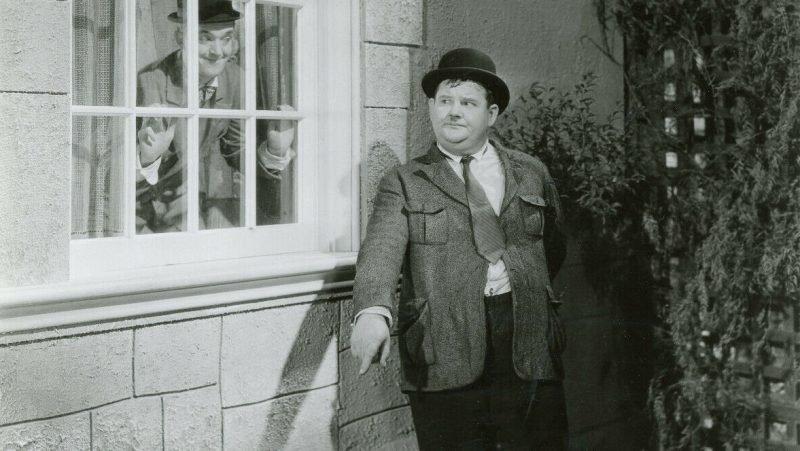Dressing Norma: Fashion in Early Cinema, on Thursday 6 October, will inaugurate a new series of annual lectures devoted to “Character, Costume Design, and Silent Cinema”. The first lecture will be delivered by fashion historian Michelle Tolini Finamore, with an introduction by noted costume designer Deborah Nadoolman Landis.
“Ladroni, the first film by Stanlio and Olio with Italian dialogue”. This is how the Rivista Quindicinale degli Spettacoli, in December 1930, announced the release of the first film in Italian by Stan Laurel and Oliver Hardy, the virtuosos of laughter. The pair were already famous internationally during the silent era, and now they faced the challenge of sound, a momentous change to which not all stars were able to adapt. Producer-director Hal Roach, who originally had the ingenious idea of pairing the two comedians, once again confirmed his intuition, deciding to produce multiple-language versions of their films for the international market. Besides acting in the original English versions, the stars had to “dub” themselves by speaking in French, German, Spanish, and Italian. This lasted a few years, until the technique of dubbing was perfected and taken over by the very talented Italian voice actors, the most famous of whom was Alberto Sordi, who for several years was the voice of Oliver Hardy. Some of the humour actually originates in the pair’s funny mispronunciation of Italian, when Laurel and Hardy were forced into a linguistic “tour de farce”; the effect was hilarious, and distributors had no doubt that from then on all Italian voice actors should stick to that model. Of the pair’s original films shot in Italian there is no trace today, but at the Giornate on Thursday 6 October, at 21.00 in the Teatro Verdi will be shown, thanks to the Project “S.O.S. Laurel & Hardy”, a version of Night Owls (directed by James Parrott, written by Leo McCarey) derived via comparison with the Spanish version, Ladrones (1930), with what remained of the negative of the same film released in Italy under the title Ladroni. The result is a short running 15 minutes longer than the film released in America, in which you will be able to hear, albeit very briefly, the voice of Oliver Hardy in a single line delivered in a mixture of Spanish and Italian. Laurel and Hardy’s famous “Cuckoo” theme appears for the first time over the credits of Ladroni, a musical motif inextricably linked with Stan and Ollie’s films.
Thursday evening’s programme on 6 October also includes the entertaining comedy Up in Mabel’s Room (1926), directed by E. Mason Hopper, featuring a sparkling performance by Marie Prevost. The Canadian-born actress plays a fashionable young lady who wants to win back at all costs the husband from whom she is divorced. At the root of it all is the purchase of a sexy chemise that generates sometimes mischievous misunderstandings, like the striptease staged by Mabel, concealed by a screen, while her ex-husband is being entertained by an admirer. The film was a big hit, inspiring a brand of lingerie launched with a big publicity campaign, filling American shops with stand-up cut-outs of Mabel wearing the chemise. The new musical score is composed by Günter Buchwald, conducting the Zerorchestra.
Speaking of divas, Thursday’s programme also includes more films from our Norma Talmadge retrospective (at 9.00 in the Teatro Verdi), which aims to remedy the undeserved oblivion of this actress for decades and bring her back into the spotlight.
Today’s offerings include Herbert Brenon’s The Sign on the Door (1921), a melodrama based on a Broadway success, and an 11-minute fragment of an adaptation of Dumas’ immortal Camille, brought to the screen in 1927 by Fred Niblo, with Norma Talmadge in the role of Marguerite Gautier, from the Library of Congress.
Also unfortunately incomplete, because it is all that remains of a key Ruritania film of great interest, is Graustark (1925), featuring Norma Talmadge (at 14.00, also in the Teatro Verdi). If in British films the hero who solves the entangled situations of the folkloric and quarrelsome Balkan states, identifiable behind the imaginary country of Ruritania, is always a gentleman, the approach in Graustark is more democratic, because the protagonist is an ordinary person. This allowed the audience to identify with the story and even imagine that the dream of marrying a nobleman or a royal could come true. Norma Talmadge is particularly convincing, sensitively directed by Dimitri Buchowetzki, who deftly exploits the beautiful settings, including a magnificent Art Deco garden. Look for a very young Joan Crawford in a small role, when she was still called Lucille LeSueur.
This year the Giornate is inaugurating a new annual lecture series dedicated to “Character, Costume Design, and Silent Cinema”. The first lecture, on Thursday 6 October at 17.15 in the Teatro Verdi, will be given by fashion historian Michelle Tolini Finamore, introduced by costume designer Deborah Nadoolman Landis, noted for The Blues Brothers and Indiana Jones. The cue for this year’s lecture is the films of Norma Talmadge, through which the history of fashion and costumes in silent cinema will be analyzed.
The online festival continues on MYmovies at 21.00, with a Ruritania film from Britain, The Runaway Princess (1929), by Anthony Asquith, starring Mady Christians.
The Giornate del Cinema Muto festival is realized thanks to the support of the Regione Autonoma Friuli Venezia Giulia, the Ministero della Cultura – Direzione Generale Cinema, the Comune di Pordenone, the Pordenone-Udine Chamber of Commerce, and the Fondazione Friuli.


 Italiano
Italiano
Recent Comments